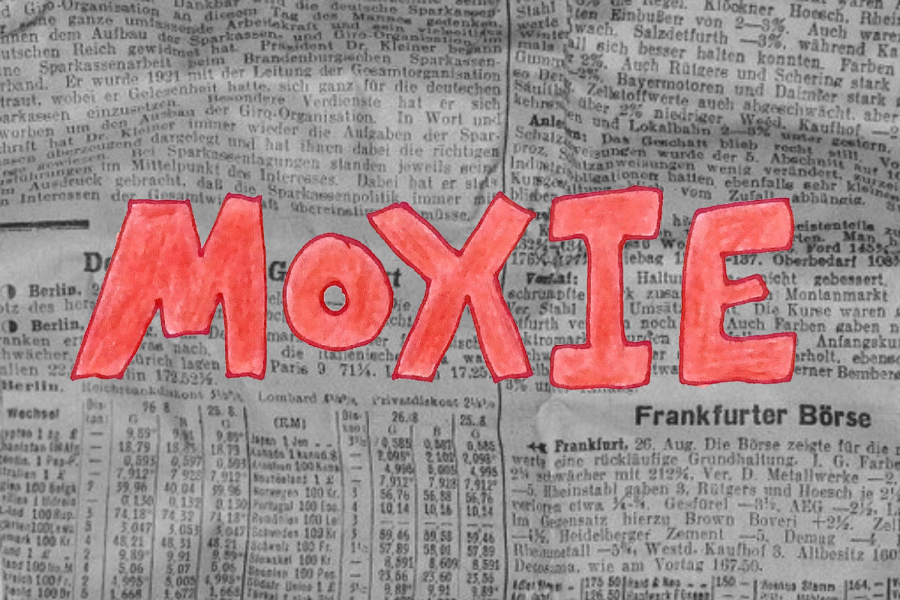“Moxie” is based on a book by Jennifer Mathieu that is about a teenager who publishes an anonymous zine calling out sexism at her school
Moxie Review: a movie lacking in moxie
April 20, 2021
This article contains spoilers and trigger warnings for mentioning rape.
Netflix released a new teen drama film titled “Moxie” on Mar. 3, 2021. The film was based on a book of the same name written by Jennifer Mathieu and was directed by Amy Poehler. Honestly, I can’t even think of a high-school romance or drama Netflix has released in the past couple of years that wasn’t originally a pastel-colored book in the YA section at Barnes and Nobles, so no shock there.
First and foremost, I want to say that the opening scene of this movie is “Twilight.” It is a girl running through the forest with a bluish-gray filter, and that really threw me off. It was not meant to be an homage to “Twilight,” it just looked like it. This half-formed beginning that could have so clearly been ripped from Edward and Bella’s story made it clear that I was in for a bumpy ride within minutes of beginning.
This movie follows a young girl, Vivian, and her journey in creating a zine– a printed collection of images and words (lyrics, stories, and more)– and the resulting wave of feminism in her school. Vivian instigates this “revolution” in reaction to the misogynistic culture at her school revealed when a new girl, Lucy, moves to town and discovers a list created by the boys ranking girls.
This was the first thing that made me a little mad. I am not above watching bad television, bad movies– it’s all ok in my book as long as it captures my attention and keeps me engaged. So, with the introduction of the concept of a list that over-sexualizes and ranks high school girls, I immediately thought, “Hey, isn’t that Thirteen Reasons Why? Or Grand Army?” Soon, I realized that it’s all of the above and more.
For some reason, the teen drama genre can only focus on feminism in one of two ways: exposing the culture of a school through the list that anonymously floats around labeling girls by body type or they hold a protest against an administration’s unfair dress code by wearing a tank top. “Moxie” does both. Every single movie about teenage feminism does both. I think the repetition is annoying and damaging; it trivializes the idea of being a feminist– especially a young feminist.
Then, I recognized a second generic repeat. At the time of the initial release of “Moxie,” Netflix had also just released a Netflix original show called “Ginny and Georgia,” which in all honesty is a whole other conversation.
However, in both of these productions, the scenes in which the outspoken feminist is identified are the exact same. It is in an English classroom, rejecting how all the books we read in high school are essentially told from the same perspective; that of an old, wealthy white guy. This is an important argument, one that should certainly be addressed within society and our school curriculum, but why did Netflix have to use essentially the same scene and argument twice? In such a short time span too.
Again, it just made me feel like there are only so many things a teenage girl is capable of feeling upset about or speaking out against.
Overall, I felt like the entire plot of “Moxie” was throwing in different issues that needed to be addressed without a cohesive plotline to tell the story effectively. There were issues within romantic relationships, friendships, and in Vivian’s home life; It was all too much with not enough focused attention on any one subject. It would have been more to the point of the movie to eliminate the element of having a boyfriend while also wholly avoiding any conflict within female relationships. Just once, I would like to see two best friends making it to the end of the story without fighting.
I have said it once, and I will say it again, the best parts of any show or movie come when the two female protagonists are working in harmony, not at each others’ throats. In “Moxie,” I found myself most enjoying the plot, not when Vivian was at peace within her relationship with her new boyfriend but when she and her friend Claudia were able to see eye to eye and come together to further their cause. I think the world would really like to see an unproblematic power duo.
Now, one thing I will say that this movie excelled in creating an incredibly aggravating, dislikable, arrogant, clearly misogynistic, waste of air antagonist. The movie’s antagonist, a jock named Mitchell, serves not only as a direct villain but also as a symbol for all the people in the world at large who carry his same misogynistic, egotistical perspective.
I did find an important lesson in the way that Mitchell was initially labeled as simply “annoying.” It is not until Lucy points out that the ways that Mitchell is “annoying” are ways in which he is legitimately dangerous that there is a shift in the narrative surrounding his behaviors. The people in his life, namely Vivian, who had previously chalked his behavior up to being acceptable and unchangeable, begin to realize that there is no excuse for the way Mitchell treats women throughout the movie.
It is at the end of the movie that it is revealed that Mitchell raped a girl the prior year, confirming him to be true evil. This is where “Moxie” really fell apart. Even if I were to forgive the myriad of issues I had with plot and execution, the way they chose to execute this would ruin everything all over again. After the rape is anonymously submitted to Vivian asking for help, she takes action in the middle of the night with a painted display. The next day this leads the victim of the assault to stand up and find a voice amongst her friends and schoolmates. But then the movie ends, just like that.
We do not get to see Mitchell being punished. In fact, all we get is the principal grabbing his arm while looking distraught that he is being accused of such a thing. In the principal’s facial expression, I felt like the last I was getting of Mitchell was him ultimately coming out unscathed. I understand that very rarely is their justice in sexual assault cases. It is far too often that the perpetrator walks free, but I think that for the sake of the plot and the argument being made about feminism, it would have been beneficial to see Mitchell facing genuine repercussions. If the point they wanted to make was, in fact, the lack of justice for victims, they should have made it clear. Watching it all unfold, it felt half-baked, like there was a forgotten final scene. Nothing was really addressed, nothing was finalized, and honestly, I don’t think anything was learned as a result.
In the end, I would give this movie a 5/10. The thought was there; it definitely was, so points for effort. But, I can think of about one hundred things they could have done differently or better. I guess you could say this movie lacked moxie.


